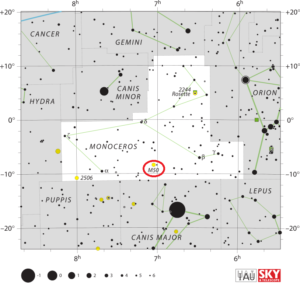| Description | |
| Visible From Pacific Northwest | November to March |
| Best Time To Observe | December, January, and February |
| Minimum Size Of Viewing Device | Small Telescope |
| Object Type | Open Cluster |
| Designations | Messier 50, M50, NGC 2323, Collinder 124, OCl 559.0, C 0700-082, MWSC 1072 |
| Right Ascension | 07h 03.2m |
| Declination | -08°20′ |
| Constellation | Monoceros |
| Number Of Stars | More Than 100 |
| Apparent magnitude | +5.9 |
| Apparent dimensions | 16′ |
| Object Radius | 10 light years |
| Distance From Earth | 3,200 light years |
History
Messier 50 was possibly discovered by the Italian astronomer and mathematician Giovanni Domenico Cassini before 1711 based on a report by Jacques Cassini, his son, in his book Elements of Astronomy (1740).
Charles Messier discovered the cluster independently and catalogued it on April 5, 1772. He noted, “I determined, in the same evening, the position of a cluster of small stars placed between the star Theta in the ear of Canis Major, & the right loins of Monoceros; I compared this cluster with the telescopic star, determined on April 3, & this one with a star of the seventh magnitude which was near the cluster.”
John Herschel catalogued M50 as h 425 and later included it in the General Catalogue as GC 1483. After observing the cluster on February 13, 1826, he noted, “Rich; compressed; fills field; stars of 10th to 15th magnitude; place [given is that] of a star of 10th magnitude in the middle – a fine cluster.”
John Ellard Gore, Irish amateur astronomer, author and one of the founders of the British Astronomical Association, studied the photographic plates taken by English astrophotography pioneer Isaac Roberts in 1893 and estimated the stellar population of M50 at about 200 stars in the cluster’s main body.
Locating M50 In The Sky
Messier 50 lies to the east of Orion, near the border between Monoceros and Canis Major constellation. It occupies an area about half the size of the full Moon and is relatively easy to find because it is located 9.5 degrees north-northeast of Sirius, the brightest star in the sky.
M50 can be found about 20 degrees along the line formed by the three bright stars of Orion’s Belt. It can be found about two fifths of the way from Sirius to Procyon, the brightest star in Canis Minor constellation and eighth brightest star in the sky.

Viewing M50
At least two or three relatively bright stars in M50 can be resolved in binoculars, while small telescopes reveal the cluster’s distinctive heart-shaped figure. 6-inch and 8-inch telescopes show at least 40 of the cluster’s blue-white stars, as well as some yellow and orange stars. The best time of year to observe M50 is in the months of December, January and February.
Photographing M50
There are some great resources to be found on the internet for tips, tricks, and guides for imaging Messier 50. There are ways to get great photos of this open cluster with spot on autoguiding and long exposures. Exposures of 10 minutes long with crisp stars have been found will stunning results.
https://www.astrobin.com/391235/?nc=collection&nce=700
Sources And Further Reading
Descriptions of all of Messier Objects can be found here.
https://www.messier.seds.org/m/m050.html
https://freestarcharts.com/messier-50

Be the first to comment on "Messier 50"